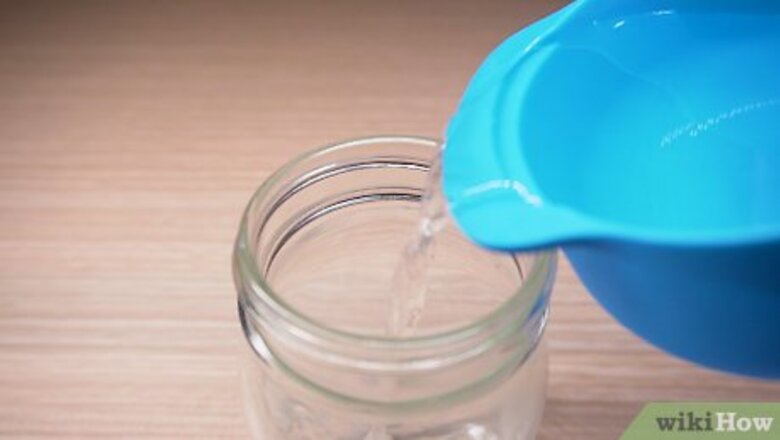
views
Forming Borax Crystals
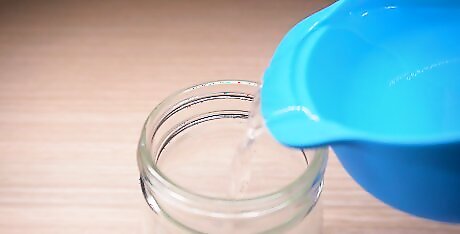
Fill a jar with 1 cup (240 mL) of hot tap water. Pour 1 cup (240 mL) of water into a pot on the stove and heat it until it boils. Then, turn off the stove, let the water sit until it stops boiling, and pour it into a glass jar with a wide mouth that you can balance a pencil on. As the water cools, the Borax will attach to fibers, like a string or pipe cleaner, to form hard crystals. Borax can be harmful when inhaled or comes in contact with your eyes, so it’s safer to add it to water that’s no longer boiling, but still just as hot. It’s important to use the right amount of water in proportion to the Borax so you can make a “supersaturated” solution. This means that there are more solid particles in the water than the water can dissolve. If you use more than 1 cup (240 mL) of water, add more Borax to ensure the solution is supersaturated.
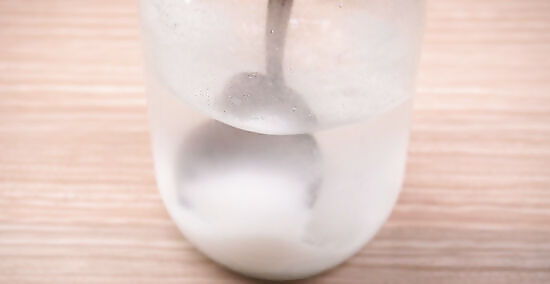
Add 3 tbsp (77.8 g) of Borax to the jar, stirring until it dissolves. Let the borax settle at the bottom. Then, combine the water and Borax with a spoon or a glass stirrer. You should see white powder floating in the water after stirring for 5-10 seconds. If you don’t see the powder floating in the water after you stir, add another 1/2 tablespoon (13 g) of Borax to oversaturate the water. Be sure to purchase the powder borax from the laundry aisle of the supermarket. Other forms of Borax, like borax soap, won’t work for making crystals.
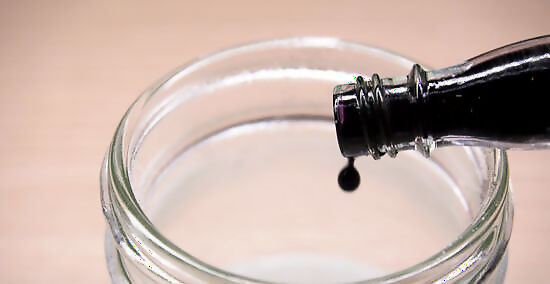
Stir in 5-10 drops of liquid food coloring if you want colored crystals. Pick one color for each jar to avoid making muddy colors that can look brown when crystallized. Remember to stir the solution for a few seconds to distribute the color evenly throughout the jar. The more drops of food coloring you add to the water, the brighter the color will be. However, if you add too much, your crystals may be smaller because the water becomes less saturated as you add the food coloring.
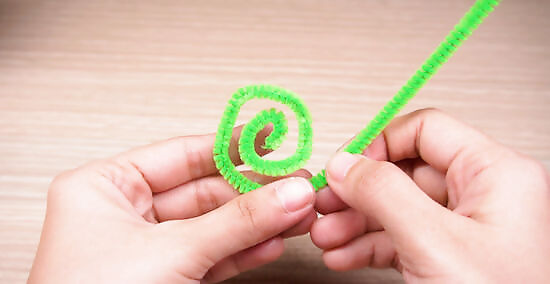
Make a shape out of pipe cleaner and tie it to a pencil to make an ornament. Bend a pipe cleaner into a simple shape, like a star, heart, square, or circle. Attach a short piece of pipe cleaner to the top of your shape by wrapping it around the top point. Wrap the other end of the pipe cleaner around a pencil. The pencil will allow the pipe cleaner to dangle in the water without touching the sides of the jar. You may want to coordinate the pipe cleaner color with the color of your crystals. Opt for a blue pipe cleaner to make a blue crystal.
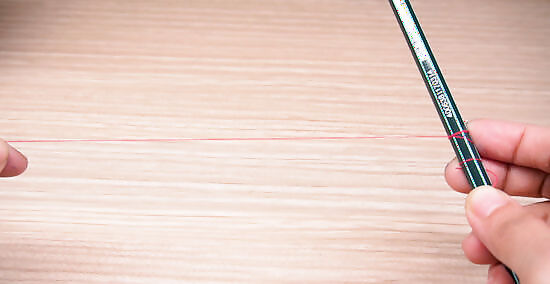
Tie a 2 to 3 in (5.1 to 7.6 cm) piece of string to a pencil for longer crystals. Cut a piece of string to fit inside the jar for the Borax to attach to. Tie one end around the center of a pencil so it can dangle in the water. If you don’t have string, use a piece of yarn or a straight pipe cleaner wrapped around the pencil. Ensure the string is short enough not to touch the jar’s bottom.
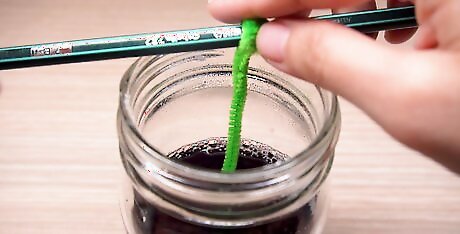
Lower the pipe cleaner into the jar, resting the pencil on the rim. Hold the pencil horizontally, and carefully move the pipe cleaner or string through the mouth of the jar and into the water. Place the pencil on the top of the jar, and look into the jar to make sure the string or pipe cleaner isn’t touching the side or bottom of the jar. If it is, adjust the position of the pencil by moving it to one side, or try re-lowering the item into the water.
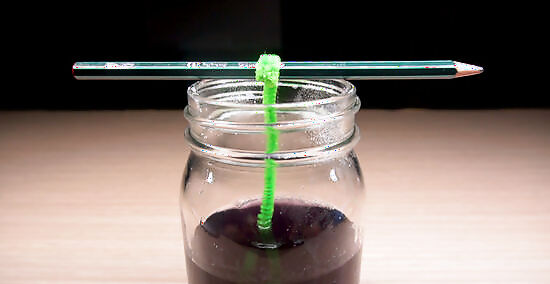
Let the crystals grow for 1-2 days before removing them from the jar. Place the jar out of the way so the crystals can grow undisturbed for at least 24 hours. After the first day, check on the crystals to see how large they are, and leave them in the solution for up to 2 days to grow larger crystals. If you notice the crystals are touching the side or bottom of the jar, remove them from the solution to prevent them from growing too large to get out of the container.
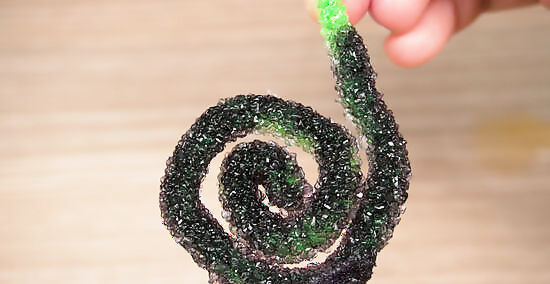
Cut the piece of string or pipe cleaner to display your crystals. The crystals have formed around the fibers of the pipe cleaner or string, so you can safely remove them from the pencil. Use scissors to cut through the top of the string or pipe cleaner, and place your crystals near a window to see its beautiful structure. You can hang the pipe cleaner ornament in a window to make a unique suncatcher.
Making Alum Geodes
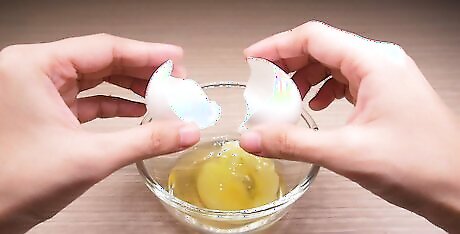
Crack or cut 1 egg in half widthwise and carefully rinse out the shells. Over a sink, use a sharp knife to cut through the shell and empty the egg into the drain. Crack the egg in half with your hands if you want a more asymmetrical look. Then, run the eggshell halves under warm water to remove any residue. Be careful when handling the eggshells. They’re very brittle and can crack and break easily if you hold or drop them too tightly.
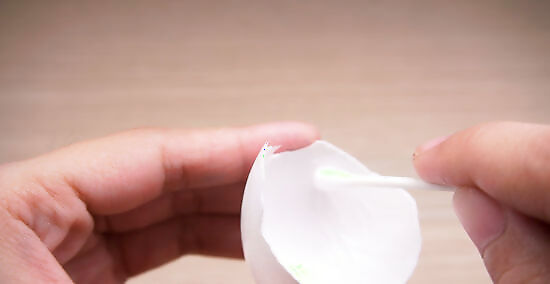
Use a cotton swab to spread a layer of glue on the shell's inside. Use a small drop of Elmer’s glue on a cotton swab. Make sure the layers are thin and cover the entire surface area where you want the crystals to grow. If you don’t have a cotton swab, use a small paintbrush to spread the glue.
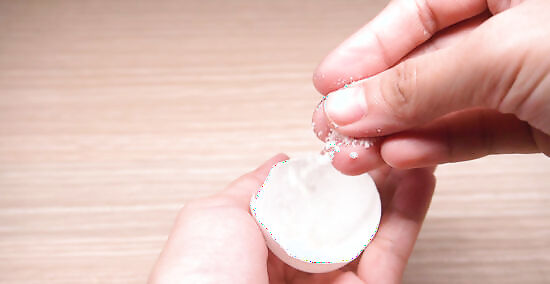
Sprinkle a pinch of alum inside each shell and let the glue dry overnight. Coated the glue with alum, which you can find in the supermarket's spice aisle. Leave the shells undisturbed for at least 6 hours to dry the glue. The alum on the egg will bond with the alum in the water as the water cools, forming a beautiful geode-like structure. It’s essential that the glue is completely dry before you grow the crystals. You can check if the glue is dry by touching the inside of each egg with your fingertip to see if the alum feels moist.
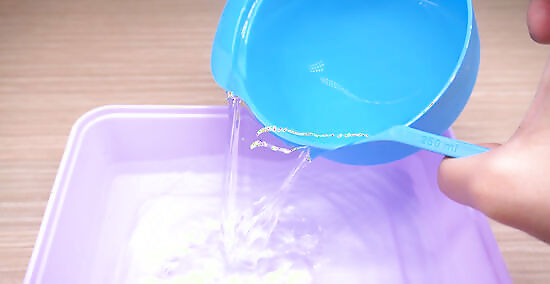
Boil 2 cups (470 mL) of water and transfer it into a container. Remove it from the heat about 2 minutes after the water boils. Let it cool for 2 minutes, then pour it into a plastic container. Make sure you use a disposable one since food coloring and alum can alter the color of the container. Always be careful when handling and pouring boiling water. It can easily splash onto your hands and arms, causing burns.
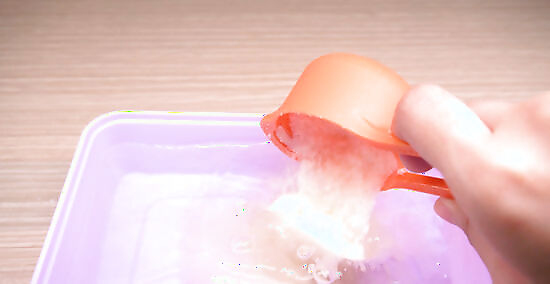
Stir in 3/4 cups (156 g) of alum, letting the solution cool for 30 minutes. Use a spoon to stir the solution until all the crystals dissolve. Touch the sides of the container every few minutes to check that the water is getting cooler. The water doesn’t have to be room temperature, but it should be cool enough to dip a finger into it.
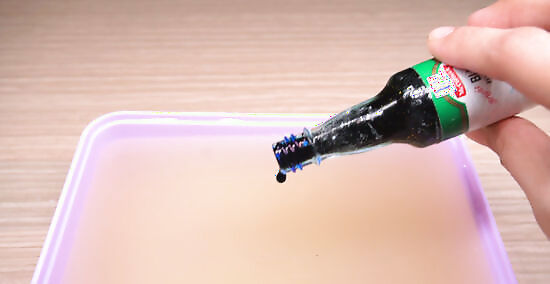
Add 40 drops of food coloring if you want colored crystals. If you plan to make colorful geodes, don’t forget to stir in the liquid food coloring. Only add 1 color at a time to the crystals to prevent them from becoming a muddy brown as they grow. Colors like blue, purple, green, and pink appear well in the alum crystals. Lighter colors like yellow likely won’t appear very bright once you remove them from the water.
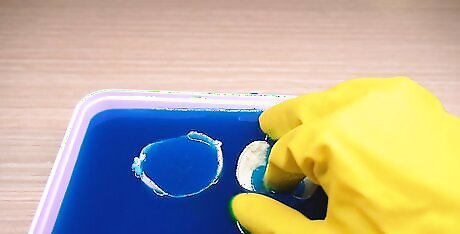
Submerge an eggshell in the solution with the open side facing up. Put on a pair of latex or rubber gloves and carefully lower one of the shells into the water. Adjust it with your hands so that the open part faces the top of the water as much as possible. Don’t worry if the shell shifts to one side or the other, as long as it’s generally positioned with the open side up. If you enter the water without gloves, you can stain your hands due to the alum and food coloring.
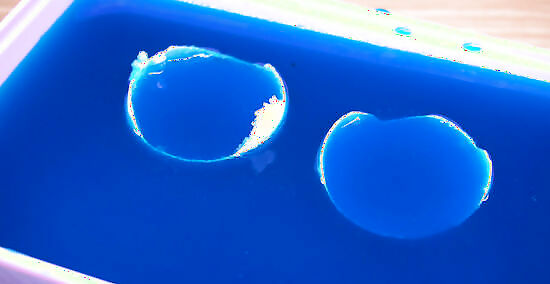
Leave the shell in the container overnight to grow before removing it. Avoid moving the containers while the crystals grow, as this can cause the egg to shift. When you’re ready to remove the crystals, put on a pair of gloves and pull the shell out of the solution, placing it on a paper towel to air dry for at least an hour. After 12 hours, you should be able to see sizable crystals on the shell, and you can leave them in the solution for up to 24 hours to grow a larger geode. The eggshell should be able to rest at the bottom of the container, with the inside facing up. If it doesn’t stay, you can also try carefully pouring the solution into the egg and letting it dry on a flat surface covered by a newspaper.
Creating Sugar Crystals
Coat a lollipop stick or string in granulated sugar. Dip a lollipop stick, bamboo skewers, or a string in a bowl of water. On a large, clean plate, pour a dusting of white granulated sugar to act as crystal seeds. The other crystals will attach themselves to the seeds. Roll the stick in the sugar, coating it evenly. Allow it to dry for 25 to 30 minutes.
Combine 1 cup (240 mL) of hot water with 3 cups (710 mL) of sugar. Boil 1 cup (240 mL) of water on a stove or microwave, or heat it in a kettle. Once it boils, add 3 cups (710 mL) of sugar in one-cup increments until it no longer dissolves. You may need to stir the sugar consistently until it dissolves. Add 20 drops of food coloring or a few drops of hard candy flavoring oil, should you choose to eat these crystals.
Pour the sugar solution into a large mason jar. Allow the solution to cool down to prevent burning yourself. Fill the jar, leaving 1 inch (2.5 cm) to 2 inches (5.1 cm) of space from the top of the jar.
Insert your stick into the solution. Place the stick coated in granulated sugar into the jar with the solution. A single jar should only hold 1 or 2 sticks to avoid making a large crystal cluster that’ll break apart or (worse!) get stuck. If you’re making more, use multiple mason jars. If using a string, tie it to a pencil or something similar and rest it atop the jar’s lip.
Allow the crystals 5 to 7 days to form. The key to a good rock candy is patience. Place the jar somewhere it won’t be disturbed. Cover the jar with a paper towel, cloth, or a coffee filter to limit evaporation. After a few days, you’ll see the formation of crystals. Remove the candy from the solution, pulling from the string or stick. A thin layer of sugar crystals may be on the solution. Use a fork or butter knife to gently crack it and pull the stick out. While you can eat the crystals after pulling them out. If you plan to use them as a party favor or for decor, allow them to dry for 4 hours.
Making Epsom Salt Needle Crystals
Stir ⁄2 cup (120 mL) of Epsom salts with⁄2 cup (120 mL) of hot water. Grab a 2 cups (470 mL) beaker, a large cup, or a bowl to combine ⁄2 cup (120 mL) of Epsom salts with ⁄2 cup (120 mL) of hot tap water for at least one minute to dissolve the salt. Add a couple of drops of food coloring if you want your crystals colored. However, opt for one color to avoid making a muddy color.
Place the beaker in the fridge for at least 30 minutes. Epsom salt crystals are known for their quick-forming results. Crystals may begin to produce within 30 minutes of being placed in the refrigerator or within a couple of hours. For the best results, leave the solution in the fridge overnight. Once you have your crystals, pour out the remaining solution to examine them. Leaving crystals in the water for too long may cause them to melt. Store your crystals in a cool, dry place, and they can last for months!
Using Table Salt
Add ⁄3 cup (79 mL) of salt to 1 cup (240 mL) of hot water. If you have time and patience, table salt is a simple ingredient to make tiny crystals. Boil 1 cup (240 mL) of hot water on a stove or tea kettle. Remove from the heat and add ⁄3 cup (79 mL) of table salt, preferably one without iodine, as this can negatively affect the crystal-growing process. Stir with a spoon until the salt dissolves. It may help to introduce salt one spoonful at a time until each batch dissolves properly. You can also add food coloring during this stage. 5 to 10 drops should suffice. You can find iodine-free salt at your local supermarket.
Pour the salt solution into a large mason jar. Carefully pour your solution into a large mason jar or shallow bowl (to speed up the evaporation process). If you’d like your crystals to grow on something, add a popsicle stick to the jar or suspend a string from a pencil on top. This is not required.
Allow your crystals to form for at least 4 days and up to 3 weeks. Salt crystals take a little while to form, so place the jar in an undisturbed location and wait for your crystals to grow in small cube-like shapes! If using a stick, you should see small, crumbly crystals form.
Making Copper Sulfate Crystals
Dissolve 200 grams of copper sulfate in 300 mL (1.2 cups) of hot water. Purchase a bag of copper sulfate to grow a vivid blue crystal. With this, you can make a bundle of small crystals or one large hand-sized crystal. Stir with a spoon until all the powder has dissolved. Your solution should be clear blue. Distilled water is the best option for this crystal. However, hot tap water works, too.
Filter the solution through a coffee filter into another jar. Remove impurities like undissolved sulfate from the solution for your crystals to grow smoothly. Use a coffee filter, paper towel, or thin strainer over another jar or bowl. Once it’s filtered, pour the new solution into a clean jar and top it with a sprinkle of copper sulfate to allow the crystals to grow. Let it sit overnight.
Store the jar for 2 days before removing a crystal. Tuck the jar on a top cabinet shelf or a similar undisturbed location. After a couple of days, small crystals will form. Grab a pair of tweezers to remove one small crystal carefully. This will be the one you’ll grow to a larger size.
Suspend the crystal from a string on a pencil. Once you’ve successfully removed the small crystal from the solution, tie one end of a piece of string or a fishing line to a stick or pencil. Then, tie the other end to the crystal.
Make another copper sulfate solution jar. In another clean jar, combine 200 grams of copper sulfate in 300 mL (1.2 cups) of hot water to make a second batch to continue the growing process.
Allow the crystals to soak in the solution for 1 month. A month may sound like a long time, but the results are worth it! The slower crystals grow, the more beautiful they’ll turn out. Leave your jar in a cool, dry location, like a cabinet, to form a single crystal. If you want to track the crystal’s progress, use a flashlight. Slow evaporation by topping the jar with a lid or damp paper towel. You should see the crystal grow each week. Remove your main crystal carefully if you notice new crystals growing at the bottom of the jar. Dump the solution into a new jar and place the main crystal back. The new crystals can slow down the process for your main crystal. Exposing the solution to the sun or fluctuating temperatures can disrupt the growing process, making the crystal jagged.




















Comments
0 comment